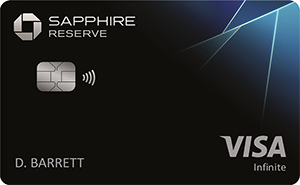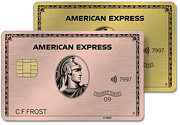When it comes to travel cards, I’m pretty vanilla. We love to travel but at this point in our lives, with young children, travel is infrequent and tends to skew towards stuff our kids like.
So while the Chase Sapphire Reserve is travel reward card royalty, we’re not at the point where we can take full advantage of the card. The annual fee of $550 but, personally, I think it’s worth it if you can take full advantage of it.
As we’ve analyzed in the past, the Chase Sapphire Reserve is a great deal. Just not for us.
So if we want something that’s close, but with features we can use, we’ve found a few that fit the bill.
Table of Contents
- Chase Sapphire Reserve (At a Glance)
- Best Alternatives to the Chase Sapphire Reserve Card
- 1. The Platinum Card from American Express
- 2. American Express Gold Card
- 3. U.S. Bank Altitude Reserve
- 4. Chase Sapphire Preferred Card
- 5. American Express Green Card
- 6. Citi Premier
- 7. Capital One Venture Rewards Card
- 8. Citi Prestige
- Summary
Chase Sapphire Reserve (At a Glance)

You get 3X points on travel worldwide and dining worldwide and 1X everywhere else. You also get a $300 annual travel credit plus complimentary Priority Pass Select Membership, and $120 in partner benefits, which rotate often and include Peloton as of this writing.
There is a welcome bonus of 60,000 Ultimate Rewards points (from their Chase Chase Travel℠ program) after you spend $4,000 in purchases within the first three months.
And, as mentioned, it has an annual fee of $550, but that is offset quite a bit if you take advantage of the annual credits.
It also comes with other travel perks such as trip cancellation/ interruption insurance, lost luggage reimbursement, and trip delay reimbursement. Check out our full review to learn more.
Now let’s check out some of the Chase Sapphire Reserve alternatives that you might prefer.
Best Alternatives to the Chase Sapphire Reserve Card
If the $550 annual fee it too much to justify, you might want to consider these Chase Sapphire Reserve alternatives.
We’ve outlined the basic benefits of each card along with the annual fee, and we’ll compare each one to the Chase Sapphire Reserve card in a summary at the end of each section.
1. The Platinum Card from American Express

You earn 5x Membership Rewards on flights and hotels booked directly with airlines or with American Express Travel.
You get a welcome bonus of 80,000 Membership Rewards points after you spend $8,000 in purchases within your first six months of Card Membership. Also, 10x Membership Rewards on U.S. gas station and U.S. supermarket purchases when you spend $5,000 in your first six months of membership. Terms Apply.
After that first six months, Membership Rewards for U.S. gas station and U.S. supermarket purchases go back down to the standard 1x.
The Platinum card also gets you complimentary access to the Delta Sky Club and complimentary Hilton Honors Gold Status.
You’ll get complimentary Gold Elite Status with Marriott Bonvoy as well. Finally, you get Global Entry application reimbursement of $100 every four years and TSA pre-check reimbursement every 4.5 years.
How does this compare to Chase Sapphire Reserve?
For the same fee, you get more welcome bonus points. And though the Amex Platinum doesn’t offer the $300 travel credit, it does offer $200 for airline incidental fees.
Membership Rewards points for travel are higher than what Chase Sapphire gives you too. If you’re a frequent traveler and book through American Express Travel, the Platinum card might be your best bet. It’s a strong competitor here.
| Chase Sapphire Reserve | The Platinum Card from American Express | |
|---|---|---|
| Annual Fee | $550 | $695 |
| Welcome Bonus | 60,000 Ultimate Rewards points after you spend $4,000 in purchases within the first three months | 80,000 Membership Rewards points after you spend $8,000 in purchases within your first six months of Card Membership |
| Rewards Structure | 3x points on travel and dining worldwide, 1x on everything else | 5x points on flights and hotels booked through American Express Travel, 1x points on everything else |
| Perks | $300 annual travel credit, $120 credit for rotating partners, complimentary Priority Pass Select Membership | Up to $200 credit for airline fees, complimentary access to Delta Sky Club, Hilton Honors Gold status, Gold Elite Status with Marriott Bonvoy, and Global Entry reimbursement. |
2. American Express Gold Card

You also get 3X Membership Rewards on flights booked directly with an airline or at American Express Travel, plus 1X on everything else.
The welcome bonus is 60,000 Membership Rewards Points after you spend $6,000 on eligible purchases with your new Card within the first 6 months.
And you get $120 of Uber cash ($10 per month) when you tie your Gold Card to your Uber account. You can use your credit on Uber rides or Uber eats.
Lastly, you pick one airline and get $100 in statement credits each calendar year.
All this for an annual fee of $250, which is less than the Chase Sapphire Reserve.
How does this compare to the Chase Sapphire Reserve?
The annual fee is less but you still get $100 of airline credit and $120 of Uber credits. It’s a cheaper card that gets you some great American Express perks but it doesn’t get you access to any airport lounges.
You have to get the American Express Platinum Card to get access to airport lounges.
If you want rewards for travel, the American Express Gold Card is worth a look.
Overall, it’s a great alternative if you can’t justify the $550 annual fee and want a card that offers similar perks and the American Express name.
| Chase Sapphire Reserve | American Express Gold Card | |
|---|---|---|
| Annual Fee | $550 | $250 |
| Welcome Bonus | 60,000 Ultimate Rewards points after you spend $4,000 in purchases within the first three months | 60,000 Membership Rewards Points after you spend $6,000 on eligible purchases with your new Card within the first 6 months |
| Rewards Structure | 3x points on travel and dining worldwide, 1x on everything else | 4x at restaurants and supermarkets on up to $25,000 in purchases per year, 3x points on flights booked with American Express Travel and 1x points on everything else |
| Perks | $300 annual travel credit, $120 credit for rotating partners, complimentary Priority Pass Select Membership | $100 annual credit for an airline of your choice and $10 per month in Uber credits, |
3. U.S. Bank Altitude Reserve
The U.S. Bank Altitude Reserve card offers several great travel benefits and a lower annual fee. The annual fee is $400 per year, and includes some attractive benefits that are fairly competitive.
There’s a 50,000 point welcome bonus (worth $750 on travel) when you spend $4,500 in the first 90 days of account opening.
You’ll earn 5x points on prepaid hotels and car rentals booked directly through the Altitude Rewards Center. And you’ll earn 3x points on all other travel purchases and 1x points on all other spending.
There’s a (up to) $325 reimbursement per year on eligible travel purchases and takeout food, dining food, and food delivery.
You’ll also get a complimentary 12-month Priority Pass Select membership that gives you access to over 1,300 VIP lounges.
And the card gives you reimbursement of up to $100 every four years for your TSA Precheck or Global Entry fees.
How does this compare to the Chase Sapphire Reserve?
The U.S. Bank Altitude Reserve card may not be as well known as some of the other cards here, but it gives the Chase Sapphire Reserve a good run for its money.
The lower fee and strong earn rates on travel make up for the lesser welcome points allocation. And the other benefits of the Altitude Reserve card make it an attractive choice for frequent travelers.
| Chase Sapphire Reserve | U.S. Bank Altitude Reserve | |
|---|---|---|
| Annual Fee | $550 | $400 |
| Welcome Bonus | 60,000 Ultimate Rewards points after you spend $4,000 in purchases within the first three months | 50,000 points when you spend $4,500 in the first 90 days |
| Rewards Structure | 3x points on travel and dining worldwide, 1x on everything else | 5x on hotels and car rentals booked through the Altitude Rewards Center, 3x points on all other travel purchases, and 1x points on everything else |
| Perks | $300 annual travel credit, $120 credit for rotating partners, complimentary Priority Pass Select Membership | Up to $325 in annual reimbursements for eligible travel and restaurants, complimentary 12-month Priority Pass Select Membership, and Global Entry or TSA Precheck reimbursement |
4. Chase Sapphire Preferred Card

The Preferred card also gives you 60,000 Ultimate Rewards points after you spend $4,000 in purchases within the first three months.
You get 2x points for travel, dining, takeout, and some restaurant delivery services. And you’ll get 25% more value for your points when you redeem them for travel through Chase Travel℠.
How does this compare to the Chase Sapphire Reserve?
At first glance, the Chase Sapphire Preferred card sounds like a viable competitor to the Reserve card.
The annual fee is much lower at $95, and the welcome bonus points are much higher. However, the Reserve card’s premium travel benefits are much better (though you pay for it with the much higher fee). You get higher purchase rewards, a $300 annual travel fee credit as well as Global Entry or TSA reimbursement – those make it a better choice for frequent travelers.
If you only travel once or twice a year, the Chase Sapphire Preferred card could be a better choice. However, if your annual travel expenses top $8,000 or so, you’ll likely be better off with the Sapphire Reserve card.
Recently, I got the Chase Sapphire Preferred card as the first card I’ve applied for in many years because I’m a big fan.
| Chase Sapphire Reserve | Chase Sapphire Preferred Card | |
|---|---|---|
| Annual Fee | $550 | $95 |
| Welcome Bonus | 60,000 Ultimate Rewards points after you spend $4,000 in purchases within the first three months | 60,000 Ultimate Rewards points after you spend $4,000 in purchases within the first three months |
| Rewards Structure | 3x points on travel and dining worldwide, 1x on everything else | 2x on travel and restaurants and 1x points on everything else |
| Perks | $300 annual travel credit, $120 credit for rotating partners, complimentary Priority Pass Select Membership | Complimentary DashPass from Doordash for up to 12 months in the first year of card ownership, up to $60 in statement credits from Peleton. Both must be activated by 3/31/22 |
5. American Express Green Card
The American Express Green Card offers 3X Membership Rewards points on travel (flights, hotels, transit, taxis, and ridesharing services) plus 3X Membership Rewards points at restaurants.
It also offers 3x Membership Rewards on transit such as ferries, buses, and subways.
The card offers a welcome bonus of 30,000 Membership Rewards points after you spend $2,000 on purchases in the first six months.
It offers and annual $100 reimbursement for Loungebuddy as well as reimbursement for CLEAR when you use your American Express Green Card to pay for those services.
It has a $150 annual fee.
How does this compare to the Chase Sapphire Reserve?
Besides offering Membership Rewards on travel purchases, it’s a travel card but not really in the same realm as the Chase Sapphire Reserve.
It has similar earn rates on travel purchases as the Reserve but lacks bonus points on dining. Which if you are traveling then you are likely also eating at restaurants, so you’d be missing out on extra points there.
However, if you take advantage of both credits for CLEAR and Loungebuddy then the annual fee is well worth the money.
| Chase Sapphire Reserve | American Express Green Card | |
|---|---|---|
| Annual Fee | $550 | $150 |
| Welcome Bonus | 60,000 Ultimate Rewards points after you spend $4,000 in purchases within the first three months | 45,000 Membership Rewards points when you spend $2,000 in the first six months |
| Rewards Structure | 3x points on travel and dining worldwide, 1x on everything else | 3x on travel, including transit, and 1x points on everything else |
| Perks | $300 annual travel credit, $120 credit for rotating partners, complimentary Priority Pass Select Membership | $100 annual reimbursement for both CLEAR and Loungebuddy. |
6. Citi Premier
The Citi Premier Card is more on the same playing field as the American Express Green Card is, but in my opinion, it’s a better card.
It offers a welcome bonus of 60,000 points when you spend $4,000 in the first three months. In addition, the annual fee is only $95.
You’ll earn 3x points on restaurants, gas stations, supermarkets, air travel, and hotels. There’s a $100 annual hotel reimbursement available when you spend $500 (excluding taxes and fees) on a single hotel stay.
The Citi Premier doesn’t have any travel insurance.
How does this compare to the Chase Sapphire Reserve?
As with the American Express Green Card, I see the Citi Premier card as being the most beneficial to infrequent travelers. If you travel a lot, the lack of travel insurance will likely be an issue at some point.
However, if that isn’t a factor for you then the Citi Premier is contender as a Chase Sapphire Reserve alternative. It has simliar earn rates and is currently offering a comparable welcome bonus.
| Chase Sapphire Reserve | Citi Premier | |
|---|---|---|
| Annual Fee | $550 | $150 |
| Welcome Bonus | 60,000 Ultimate Rewards points after you spend $4,000 in purchases within the first three months | 60,000 points when you spend $4,000 on purchases in the first three months |
| Rewards Structure | 3x points on travel and dining worldwide, 1x on everything else | 3x on restaurants, gas, supermarkets, flights, and hotels, and 1x points on everything else |
| Perks | $300 annual travel credit, $120 credit for rotating partners, complimentary Priority Pass Select Membership | $100 annual hotel credit if you spend $500 on a single hotel stay. |
7. Capital One Venture Rewards Card

The annual fee for this card is $95.
You’ll earn an unlimited 2x miles per dollar on every purchase, every day with the Venture card. You’ll get reimbursed up to $100 every four years for TSA precheck or Global Entry fees.
And you can use your Venture miles on hotels, flights, and more.
How does this compare to the Chase Sapphire Reserve?
While the welcome bonus miles for this card are attractive, this is another card for infrequent travelers.
The rewards miles are 2x instead of 3x points with Chase, and most of the other travel benefits of the Sapphire Reserve card are absent here. If you spend a lot on travel you’ll be missing those bonus points.
The Venture is a great card for everyday spending but if you want a card specifically for travel purchases this one might be the best.
👉 Learn more about Capital One Venture Rewards
| Chase Sapphire Reserve | Capital One Venture Rewards Card | |
|---|---|---|
| Annual Fee | $550 | $95 |
| Welcome Bonus | 60,000 Ultimate Rewards points after you spend $4,000 in purchases within the first three months | 75,000 miles when you spend $4,000 on purchases within the first 3 months of opening the account, equal to $750 in travel |
| Rewards Structure | 3x points on travel and dining worldwide, 1x on everything else | 2x miles on every purchase |
| Perks | $300 annual travel credit, $120 credit for rotating partners, complimentary Priority Pass Select Membership | $100 reimbursement for Global Entry or TSA Precheck |
8. Citi Prestige
The Citi Prestige card is no longer accepting applications.
The Citi Prestige card offers a welcome bonus of 50,000 points when you spend $4,000 within the first three months of opening your account. You can redeem those points for $500 worth of travel when booked through Citi’s travel center.
The annual fee for the Citi Prestige is $495; slightly lower than the Chase Sapphire Reserve’s annual fee.
This card offers 5x rewards points on both air travel and on restaurants. And it pays 3x points on hotels and cruises.
You can earn up to $250 in travel credit each year, and Citi will reimburse your Global Entry or TSA Precheck fee up to $100 every five years.
You’ll also get complimentary access to hundreds of VIP lounges through Priority Pass Select.
How does this compare to the Chase Sapphire Reserve?
Both the welcome bonus and the annual fee are lower, which makes the differences offset each other pretty comparatively.
The 5x rewards points on air travel and restaurants with the Citi Prestige is a nice feature, especially if you spend a lot in these areas. If you’re spending $20,000 a year in those two areas, you’ve already surpassed the rewards you would have earned with the Sapphire Reserve.
The one area where this card fails is in the area of travel protection. It doesn’t have any. If you’ve got a low risk personality that loves the idea of travel protection, you may want to stick with the Sapphire Reserve.
| Chase Sapphire Reserve | Citi Prestige | |
|---|---|---|
| Annual Fee | $550 | $495 |
| Welcome Bonus | 60,000 Ultimate Rewards points after you spend $4,000 in purchases within the first three months | 50,000 points when you spend $4,000 in the first three months |
| Rewards Structure | 3x points on travel and dining worldwide, 1x on everything else | 5x points on flights and restaurants, 3x on hotels and cruises, and 1x points on everything else |
| Perks | $300 annual travel credit, $120 credit for rotating partners, complimentary Priority Pass Select Membership | $250 annual travel credit and Global Entry or TSA Precheck reimbursement |
Summary
The Chase Sapphire Reserve card’s annual fee can be a bit much to swallow at $550 per year. However, for frequent travelers or those who tend to take expensive vacations, the Reserve card’s annual fee is well worth the benefits and rewards it offers.



